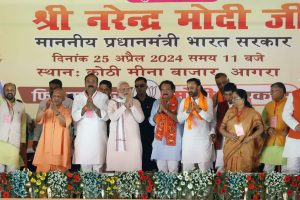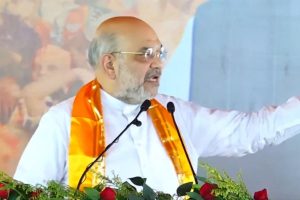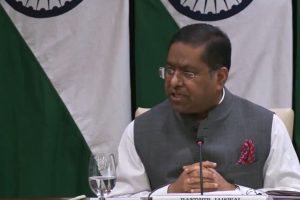It is obvious that Modi remains an obstacle to the BJP&’s hope of making it to Delhi. The party&’s calculation is that if it can win close to 200 seats on its own, it will not have any difficulty in winning over allies. But, as the surveys show, it is falling well short. Evidently, the Modi magic is not working for it as effectively as it presumed ~ AMULYA GANGULI
While opinion polls about the forthcoming general election have confirmed the conventional wisdom that the Congress is faltering, the BJP&’s gains by default aren’t enough to enable it to enter the corridors of power in Delhi. According to one assessment, the Congress is likely to win 119 seats while another study puts the party&’s tally at 131/139. As for the BJP, it is expected to win 131 seats as per the first survey and 156/164 according to the second.
However, these tallies are not a guaranteed route to power since much will depend on how many allies the National Democratic Alliance (NDA) led by the BJP and the United Progressive Alliance (UPA) under the Congress are able to attract from among the regional parties in order to cross the half-way mark of 272 Lok Sabha seats out of a total of 543.
In this matter of winning friends and influencing people, the NDA may be at a disadvantage if Narendra Modi is at its helm because, except for a few like the AIADMK of Tamil Nadu, the Asom Gana Parishad of Assam and the Indian National Lok Dal of Haryana, most of the other regional parties will shy away lest any proximity to the NDA and, therefore, the BJP hurts their bases among the minorities.
Among those who are likely to stay away although they were the BJP&’s allies earlier are Trinamul Congress of West Bengal, Biju Janata Dal (BJD) of Odisha and Telugu Desam of Andhra Pradesh, not to mention Janata Dal (United) of Bihar.
The Congress will be slightly better placed since the parties which are likely to support it will include those who support it now, viz. the Samajwadi Party and the Bahujan Samaj Party (BSP).
In addition, the Janata Dal (United) may be on the Congress&’s side even if the latter maintains its present formal tie-up with the Rashtriya Janata Dal (RJD), which is the Janata Dal (United)&’s mortal enemy in Bihar. The reason is that having broken its ties with one national party, the BJP, the Janata Dal (United) will need to be friendly with another national party like the Congress since it may not find a place of honour among the other regional parties.
Why this may be so is because of the sharp differences between the regional parties. In fact, the mutual antipathy among some of them is so strong that these parties are likely to form two antagonistic blocs. Such an outcome is inevitable because the DMK will not be the member of any formation which includes its arch rival in Tamil Nadu, the AIADMK. Similarly, the Left will shun any alliance which includes Trinamul, its old adversary in West Bengal, and the Samajwadi Party cannot be expected to cohabit with the BSP.
The result of such divisions is that the so-called alternative to the Congress and the BJP will be weakened unlike, say, in 2008-09 when the Third Front conjured up by the CPI-M&’s Prakash Karat dreamed of coming to power with the BSP&’s Mayawati as the Prime Minister. The division among the regional parties cannot but compel most of them to gravitate towards the two national parties, with the Congress proving to be the more suitable wooer because of its secular image.
It is obvious, therefore, that Modi remains an obstacle to the BJP&’s hope of making it to Delhi. The party&’s calculation is that if it can win close to 200 seats on its own, it will not have any difficulty in winning over allies. But, as the surveys show, it is falling well short. Evidently, the Modi magic is not working for it as effectively as it presumed.
While the party is expected to do well in northern, central and western parts of the country, it is drawing a blank in the south. Interestingly, even Rahul Gandhi is more popular than Modi in the south. Clearly, the party&’s defeat in Karnataka following the scams which affected its government in the state has hit it badly in the region.
Since the BJP is also weak in the east, viz. West Bengal and Odisha while its position is uncertain in Bihar, the party will find it extremely difficult to get close to the coveted figure of 272. However, the party can draw some satisfaction from the forecast that it will emerge as the No. 1 outfit in UP, ahead of the Samajwadi Party and BSP with the Congress relegated to the fourth position.
But, if the Samajwadi Party and the Congress revive their earlier alliance in the state, the BJP will run into trouble. Considering how the Akhilesh Yadav government&’s image has been damaged by the controversy over the Durga Shakti Nagpal issue, the poor law and order situation and, above all, by the weakness of the chief minister vis-à-vis his father and uncles, the Samajwadi Party will probably have no option but look for a helping hand from the Congress lest it is overrun by a resurgent BSP.
The Congress, on its part, will hope for Modi frightening away the minorities in sufficient numbers to put Delhi out of the BJP&’s reach, and for the economy to show signs of life as the result of a fresh emphasis on reforms, exemplified by the relaxation of FDI norms, so that it can hang on to power, even if its finger nails.
The writer is a former Assistant Editor, The Statesman











